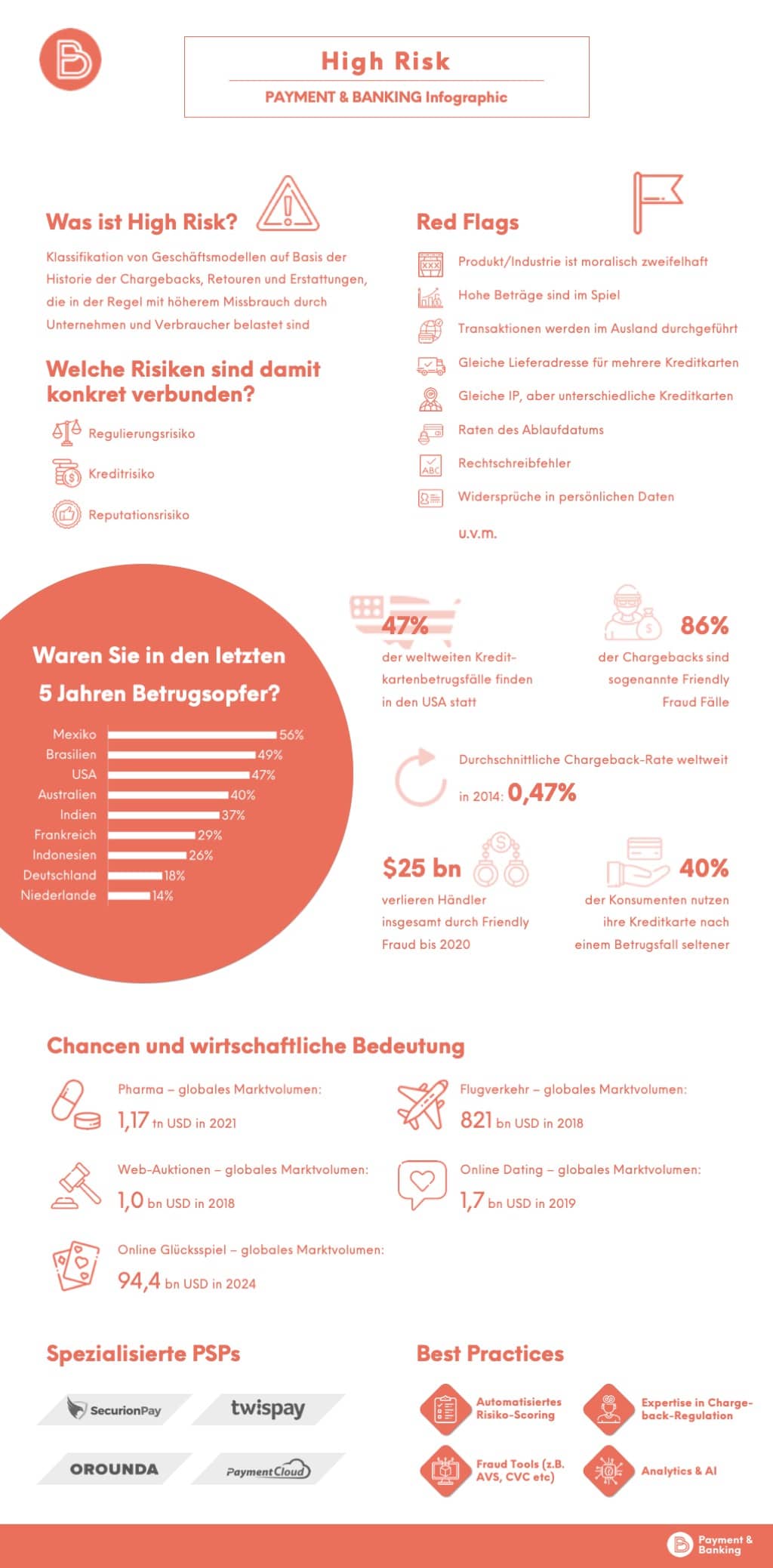Der Begriff „High Risk“ kommt einem zwangsläufig unter, wenn man sich etwas näher mit der Materie „Payment“, im Speziellen „Online Payment“ und noch spezieller „Kreditkarte“, beschäftigt. Oft erschleicht einen das Gefühl, dass der Begriff „mal eben so dahin gesagt wird.“ Und wenn man etwas tiefer bohrt, können kaum schlüssige Erklärungen ans Tageslicht gebracht werden.
Wir wollen uns dem Thema widmen: Was ist High Risk und: Was ist konkret damit gemeint?
Hier die allgemeine Definition:
“High Risk is a term used by financial institutions to classify specific business models based on those models‘ overall history of chargebacks, returns, and refunds. Additionally, these business models are usually burdened with higher levels of abuse by both businesses and consumers.

If your business model is perceived as High Risk, it does not necessarily indicate that your business is at a higher risk of chargebacks. It only means that your business model and the Merchant Category Code (MCC) in which your business falls are classified in such manner. A Merchant Category Code (MCC) is a four-digit number used to classify a business entity based on the type of goods or services the company provides.”
Mit dieser Definition ist die Conclusio “High Risk = High Charge back” ausgehebelt. Der Zusammenhang ist nicht gegeben. Heißt auch für einen Payment Provider (v.a. einem ACQ): man kann mit “High Risk” im Sinne der MCC Codes ein gutes Geschäft machen, ohne sich seine Fraud Ratio zu ruinieren.
“Though high risk businesses may be profitable, they can run into problems taking payments due to the financial history, transaction types and how the transactions are processed for that particular business segment. These factors affect MCC classification industry-wide.”
Im „Payment-Sprachgebrauch“ sind damit Händler bzw. Transaktionen aus bestimmten Branchen zusammengefasst. Hier eine erste Übersicht:
Overview of all high risk accounts:
- 1-800-type chat sites
- Airlines or airplane charters
- All sexually-oriented or pornographic merchants: (i.e., companion or escort services, adult telephone conversations, adult bookstores, dating services, online adult membership or matchmaker services, adult paraphernalia or toys)
- Amazon, Yahoo or Google Stores
- Annual contracts
- Antiques
- Attorney referral services
- Auctions
- Automotive brokers
- Bankruptcy attorneys
- Brokering
- “Business opportunities”
- Casinos, Gambling or Gaming
- Check Cashing Services
- Cigarettes, E-cigarettes, or vape shops
- Coins, collectible currency, or autographed collectibles
- Collection Agencies
- Coupons or rewards-points programs
- Credit protection, counseling, or debt repair services
- Debt collection services
- Discount health or medical care programs
- Debt consolidation services
- Drug paraphernalia
- eBay stores
- eBooks (copyrighted material)
- Electronics
- Event ticket brokers (unlicensed or non-registered (i.e., Stub Hub-type merchants))
- Exporting services (non-US based)
- Extended warranty companies
- Fantasy sports websites
- Federal Firearms License (FFL) dealers
- Finance brokers, financial consulting, or loan modification services
- Furniture sellers
- Indirect financial consulting (i.e., “How to Save Money by Lowering Your Electric Bill”)
- Financial planning, strategy or advising
- “Get rich quick” books, programs, etc.
- High average ticket sales
- “How-To”-type websites (i.e., “Learn How to Make Money on The Internet”)
- Horoscopes, astrology or psychic services, fortune tellers
- “Hype” products or services
- Hypnotists or self-hypnosis services
- International merchants (non-US based) operating in the United States
- International shipping, cargo, or import/export
- Investment firms, strategy, or books
- Life coaching
- Lingerie sales
- Lotteries or sweepstakes
- Magazine sales and subscriptions
- Mail or telephone order sales
- Membership organizations (contracts over 12 months)
- Merchants on the Terminated Merchant File (TMF) or MATCH List
- Merchants with poor credit
- Modeling or talent agencies
- Multi-currency sales
- Multi-level marketing (MLM) sales tactics
- Music, movie, or software downloads or uploads (i.e., copyrighted digital products)
- Non-US citizens doing business in the United States
- Off-shore corporation establishment services
- Pawn shops
- Prepaid calling cards
- Prepaid debit cards
- Real estate
- Replica handbags, watches, wallets, sunglasses, etc.
- Self-defense, pepper spray, mace, etc.
- SEO services
- Social networking sites
- Sports forecasting or odds-making/betting
- Telecommunications
- Telemarketing services
- Telephone companies
- Third-party processing, factoring merchants (i.e., payment processors, vacation rental brokers)
- Time-shares or time-share advertising
- Tour operators
- Travel clubs, services, or agencies
- Vacation planners
- Vacation rentals (unless the property is owned by the merchant)
- Vitamin and supplement sales (i.e., diet pills, prescription pills, health supplements, pharmacy products)
- VoIP services
- Weapons of any kind, including guns, knives, stun guns, or ammo. Also includes any parts of weapons (i.e., butts, triggers, magazines, etc.)
Wie man sehen kann, eine “sehr breit” aufgestellte Liste. Und am Ende betrifft es auch “normale Geschäftsmodelle” wie z.B. Airlines oder Reisebüros. Der “Grund” warum bestimmte Geschäftsmodelle hier “verhaftet” werden ist oft unterschiedlich.
Wie definieren es die Schemes selbst?
Visa
“Visa classifies high-risk material (selling downloadable, digital merchandise and/or services) under Merchant Category Codes 5962, 5966, 5967, 7995, and is only available to merchants in the Visa, Inc. regions of United States, Canada, and Europe.”

MasterCard
“MasterCard considers high-risk material (selling downloadable, digital merchandise and/or services) under Merchant Category Codes 5967, 7841, 7994, 7995, and is only available to merchants in the MasterCard regions of United States, Canada, and Europe.”
Schauen wir uns das Thema etwas genauer an:
Im Payment-Kontext gibt es unterschiedliche Akteure – Konsumenten, Händler, Issuer, Acquirer, Schemes, Regulatoren, jede Menge technische Dienstleister. Nun stellt sich die Frage: Wer hat nun wirklich ein „Risiko“ und wenn ja, welches? Dazu teilen wir die Risiko-Typen in folgende „Klassen“ ein:
Klasse 1 – Finanzielles Risiko
- Für den ACQ
- Für den PSP
- Für den Endkunden
- Für das Scheme
Klasse 2 – Reputationsrisiko – „Wie hoch ist das Risiko, dass meine Reputation Schaden nimmt?“
- Für meine Kunden
- Für meine Investoren
- Für meinen Brand
- Für mein Management
Klasse 3 – Lizenz/Compliance-Risiko – „Wie hoch ist das Risiko, dass ich von meinem Lizenzgeber, sei es der Regulator oder auch das Scheme, Probleme bekomme?
- Finanzielle Themen è Strafe
- Entzug der Lizenz è Geschäftsgrundlage
Die Klassifizierung zeigt, dass wir es hier oft mit konkurrierenden Zielen zu tun haben. Gleichzeitig ist es für den ein oder anderen Akteur das Spiel eines „Doppelagenten“. Konkret: Warum soll ich die Akteure mit Strafen belegen, die mir auf der anderen Seite das Geschäft bringen? Wer spielt in dem Kontext mit? Hier eine Liste aus den USA. Die meisten von uns werden niemand jemals gehört haben.
„Für manche Akteure ist es das Spiel eines ‚Doppelagenten‘.“
Conclusio:
Das Thema „Risiko“ wird immer noch zu sehr als „schwarz/weiße“ Aussage gesehen. Risiko ist aber zu großen Teilen „grau“. Aber auch eine massive Opportunity (Risiko ist Business). Wenn man die Grauzonen (egal welcher Akteur man in der Wertschöpfungskette des Online-Payment ist) richtig managed, kann daraus ein signifikanter Wettbewerbsvorteil entstehen.
Risiken sind selten zu verhindern. Das ist eine Tatsache und damit eine Chance. Risikoverhinderung ist eine Illusion. Mit diesem Mindset kann man daraus wirkliche und auch nachhaltige Bsuiness-Opportunities generieren. Der größte Feind ist hier die „Unwissenheit“ und damit verbunden auch das schwer greifbare Risiko der „Reputation“. Für eine Wachstumsstory im „economies of scalte“-Markt „Payment“, ist das Thema Risiko der Hebel um in den Markt zu kommen. Das hat in der Vergangenheit geklappt – das wird auch weiter klappen. Die Incumbents sind dafür viel zu träge. Dort steht oft das persönliche (=Mitarbeiter) Risiko deutlich über der Opportunity. Dies zeigt auch die Tatsache, dass Firmen, die über „Risiko“ groß geworden sind, in der Regel Companies ohne starke, öffentliche Investoren sind. Oft werden diese über das Management stark geführt bzw. sind auch in deren Hand. Darüber erledigt sich die ein oder andere Diskussion.

Hier die Grafik in Gänze zum Download
Quellenangaben:
- https://www.statista.com/statistics/270728/market-volume-of-online-gaming-worldwide/
- https://www.statista.com/outlook/372/100/online-dating/worldwide
- https://blog.marketresearch.com/the-growing-pharmaceuticals-market-expert-forecasts-and-analysis
- https://www.businesswire.com/news/home/20180801005715/en/Global-Online-Auction-Market-2018-2022-Ease-Bidding
- https://www.statista.com/statistics/278372/revenue-of-commercial-airlines-worldwide/
- https://www.iata.org/pressroom/facts_figures/fact_sheets/Documents/fact-sheet-industry-facts.pdf
- https://www.kount.com/blog-against-fraud/11-frightening-chargeback-statisticshttps://bizplus.ie/what-are-worst-countries-for-credit-card-fraud/
- https://www.paypal.com/cs/smarthelp/article/what-are-common-scams-and-how-do-i-spot-them-faq3176
- https://www.chargebee.com/blog/optimize-online-billing-stop-online-fraud/
- https://www.ecb.europa.eu/pub/cardfraud/html/ecb.cardfraudreport201809.en.html
- https://www.bankcardbrokers.com/high-risk-payment-processing-whats-a-merchant-to-do-infographic/
- https://www.cardwatch.org.uk/types-of-card-fraud.htmlhttps://www.ublocal.com/atm-fraud/
- https://www.dailymail.co.uk/news/article-2378322/Feds-say-hackers-stole-160-Million-credit-card-numbers-largest-data-theft-case-prosecuted-U-S.html
- https://krebsonsecurity.com/2013/07/hacker-ring-stole-160-million-credit-cards/
- https://frankonfraud.com/fraud-trends/us-card-fraud-hits-staggering-8-billion-in-losses-up-20-again/
- https://www.mckinsey.com/industries/financial-services/our-insights/fraud-management-recovering-value-through-next-generation-solutions






